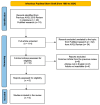Open Surgical Conversion of Popliteal Endograft Infection: Case Reports and Literature Review
- PMID: 39200319
- PMCID: PMC11351597
- DOI: 10.3390/biomedicines12081855
Open Surgical Conversion of Popliteal Endograft Infection: Case Reports and Literature Review
Abstract
Background: Endovascular treatment of popliteal aneurysms (PA) has increased in the last few years, quickly becoming the main treatment performed in many vascular centers, based on the acceptable and promising outcomes reported in the literature. However, endograft infections after endovascular popliteal aneurysm repair (EPAR) are the most dangerous complications to occur as they involve serious local compromise and usually require open surgical conversion and device explantation to preserve the affected extremity.
Case report: We report two patients who were admitted to the emergency room of our hospital for pain and edema in the lower leg. Both patients had undergone exclusion of a ruptured PA a few years before by endovascular graft. CTA testing showed a significant volume of fluid-corpuscular collection related to perianeurysmal abscess collection in both cases. Blood cultures and drained material cultures were positive for Staphylococcus capitis in the first case and S. aureus in the second. Prophylactic antibiotics were administered for 10 days, then patients underwent an open surgical conversion with the complete explantation of endovascular material and a femoro-popliteal bypass using an autologous vein in the first case and a biological bovine pericardium prosthesis in the second case. The infective department of our hospital had defined a discharged specific antibiotic therapy for each patient, based on intraoperative microbiological samples. Furthermore, we have examined the literature and found six more cases described in case report articles that refer to popliteal graft infections by different microorganisms, mostly presenting acute limb ischemia as the first symptom and suggesting endograft explantation with open conversion and autologous vein bypass as the commonest therapeutic choice.
Conclusions: The open surgical conversion of popliteal endograft infection is the best strategy to manage peripheral infection after an endovascular popliteal aneurysm repair procedure.
Keywords: endograft infection; open surgical conversion; popliteal aneurysm; popliteal endograft infection.
Conflict of interest statement
The authors declare no conflicts of interest.
Figures






References
Publication types
LinkOut - more resources
Full Text Sources

